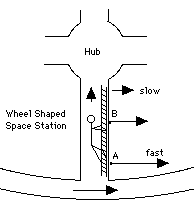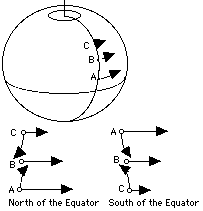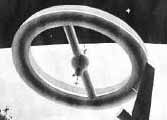(24) Rotating Frames of Reference in Space and on Earth"Zero g"An astronaut in low Earth orbit moves in (approximately) a big circle extending around the Earth. The acceleration required for such motion is provided by gravity mg(RE/ r)2= mv2/ r where the astronaut's weight mg on the Earth's surface at r = RE is adjusted on the left side for the greater distance. That is of course the same equation as the one used to demonstrate Newton's study of gravity. However, it can also be written mg (r/ RE)2 - mv2/ r = 0 That can be interpreted as stating that in the astronaut's frame of reference, all bodies are subject to two forces, gravity and the centrifugal force, and the two are in perfect balance, adding up to zero. It is sometimes claimed that astronauts in space are in a "zero gravity" environment, but actually they are still very much under the influence of the Earth's gravity. True, the astronaut observes no tendency at all to fall towards Earth, but the reason is different and can be stated in one of two ways:
Take your choice! The Coriolis Force
The science-fiction film "2001: A Space Odyssey" featured spinning space station, whose rotation provided the crew with "artificial gravity." It was a wheel-shaped structure, with hollow spokes connecting the wheel to a cabin in the center (drawing). The cabin in the middle was where transfers between the station and visiting spacecraft took place. Click here for more on that design. Given such a rotation, something like gravity would indeed be produced, with "down" being towards the outside (Larry Niven expanded that notion into the fanciful science-fiction novel "Ringworld" and its sequels). When calculating this effect it is simplest to use the station's frame of reference and add a centrifugal force to all other forces there. However, when one moves in this rotating environment, especially motion up and down the spokes, an additional force is encountered, named for the Frenchman Gaspard Gustave de Coriolis (1792-1843). 
Imagine an astronaut moving along one of the spokes, say from point A in the drawing to point B--most likely, climbing a ladder, since such motion goes against the station's "artificial gravity." At any point, as viewed in the frame of the outside world, the astronaut is also rotating around the station's axis. At both point A and B, the rotation is in the same direction, but at B it is slower, because that point is nearer to the axis of rotation and therefore describes a smaller circle. What happens at B to the extra speed the astronaut had at A? According to Newton's first law, loosely applied, the astronaut would tend to keep that extra speed and would therefore be pushed agains the side of the spoke (direction of the arrows). That push is the Coriolis force. When the motion is in the opposite direction, from B to A, the direction of the force is. . . the same or reversed? Work it out yourself! Swirling Water in a Bathroom SinkFrom time to time the claim is made that water draining from bathroom sinks swirls in opposite directions north and south of the equator. The physical principle is sound, but the actual effect is so microscopic that it is unlikely to be observed in the draining of bathroom sinks. On the other hand, the same effect is very important in large-scale swirling of the atmosphere, in hurricanes and typhoons as well as in ordinary weather patterns. 
The Earth, when viewed from above the north pole, spins counter-clockwise. Imagine 3 points in the northern hemisphere, at the same geographical longitude (drawing)--A closest to the equator, B somewhat poleward and C further poleward still. Each of these points covers in one day a full circle around the Earth's axis: A has the biggest circle, goes the greatest distance and therefore moves the fastest, B with a small circle moves more slowly, and C is even slower. The points are redrawn on the right on a magnified scale, with arrows attached to indicate the directions and magnitude of their velocities. Now imagine that for some reason a low-pressure area has developed in the atmosphere at point B. Air will tend to flow towards B from both A and C, but as it does so, it tends to keep its speed of rotation, like the astronaut in the preceding example. Thus the actual flow from A (dotted arrow) ends up ahead of B, deflected to the right (in the rotating frame), and the flow from C ends up lagging behind B, deflected to the left. The result is the same as the addition of a counterclockwise swirling around B. Imagine next that the points are moved to the southern hemisphere, reversing their order, so that A remains closest to the equator and is still the fastest-moving point of the three. The flow from A is still deflected to the right and the one from B to the left, but because the north-south order of the points is now reversed, the resulting swirling is clockwise.
Big storms in the atmosphere are usually centered on low-pressure areas and conform to those rules. This was first observed in weather patterns in 1857 by Christoph Buys-Ballot in Holland, though William Ferrel in the US had predicted the phenomenon using arguments like the ones given here. But don't expect to observe the effect in bathroom sinks. Water draining from a sink will usually swirl, because any rotation it has is greatly speeded up as it is drawn to the center of the sink. A slow circulation near the edges of the sink, e.g. because the sink itself is not completely symmetrical, becomes a fast vortex in the middle. The rotation of the Earth, however, is a much smaller factor than an uneven shape or heating of the sink, or a slow motion left from the time the sink was filled. If all 3 points A,B,C are inside the sink, with B at the drain, the difference in rotation speed (around the Earth's axis) between point B and either of the other two is typically only about 0.001 millimeter per second or about 1/7 of an inch per hour. |




